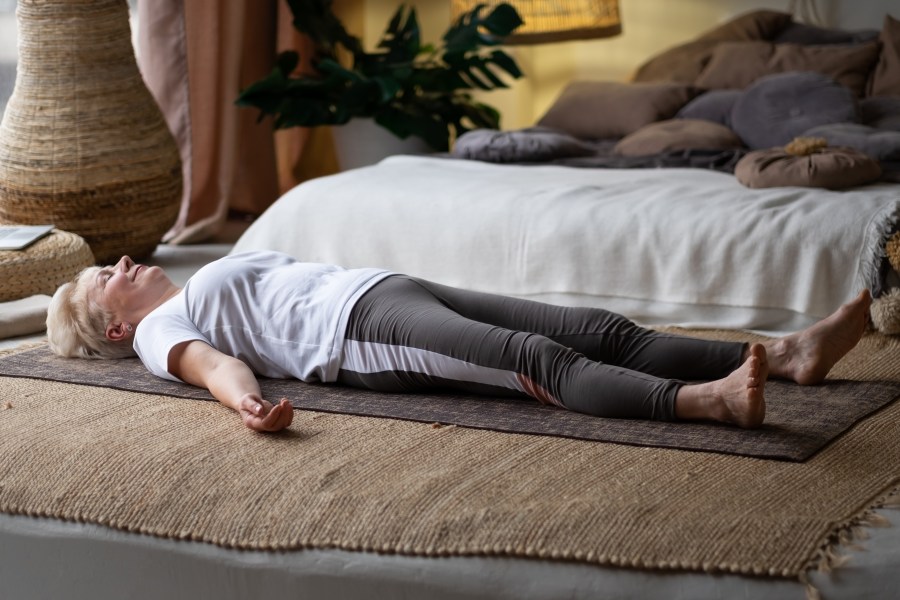Struggle to drift off in the evening or wake in the night and can’t get back to sleep? Try restorative yoga for better sleep, says Gemma Sprack.
Have you ever reached the end of a yoga class and drifted off in savasana? The reason you’re feeling so chilled is because yoga is a really effective way to down-regulate stress hormones in the body. It also shifts your central nervous system into ‘rest and digest’ mode, enabling you to focus on the here and now rather than worry about what might happen in the future.
If a busy mind is keeping you awake at night, this restorative yoga for better sleep will give you the chance to press pause. Take your time to really settle into each pose and make it as comfortable as you can – use as many pillows as you need and deal with any little niggles at the start. If your mind is overactive, direct your focus to your breathing and find a steady rhythm. Notice where you feel the breath and how it sounds – if there are any pauses when your thoughts kick in, simply acknowledge them then bring your focus back to your breath. When you’re settled, try to stay as still as possible in the poses.
Your yoga for better sleep plan is divided into three sections. Sleep Secrets has two postures to help you let go of a busy day and calm your body in readiness for bed. Night Moves offers two options to help you get back to sleep if you wake up in the night, and Morning Refresh has two poses and a gentle flow to help rejuvenate you if you’ve had a bad night’s sleep.
I’ve given suggestions for timing, but your body will tell you when it’s ready to leave the pose. Trust your instincts and listen to those cues, and enjoy this yoga for better sleep sequence.

Gemma Sprack is a yoga teacher, yoga therapist and founder of The Feel Good Collective.
Restorative yoga for better sleep
Use these poses before bed to help relax your body
Legs up the wall
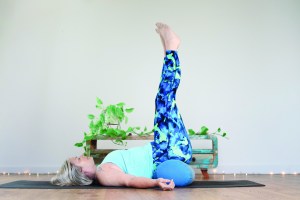
Time: 2-20 minutes
Why it helps: This pose reverses the effects of gravity on your feet and legs, helping your circulation and creating a feeling of calm throughout the body.
Getting there: Find a surface to rest your legs against, whether a wall, the back of the door or edge of the bed. Come to rest on your back with your bottom as close to that surface as possible. Extend your legs straight up and allow them to relax. Your arms can rest wherever feels most comfortable – by your side, on your tummy or above your head. Place a pillow/folded blanket underneath the hips if it feels good.
Being there: Once you’ve settled, begin to focus on your breathing. Take three big, deep breaths – in through the nose, sighing out through the mouth. Then, allow your breathing to settle into a natural pattern and begin to gently scan your body from head to feet, noticing areas of tension and encouraging them to soften. Use your exhalations to create a sensation of ‘deflating’ and allow yourself to feel as though you are gently melting into the floor.
Forward fold (yin variation)
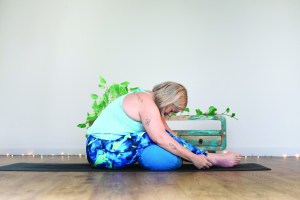
Time: 2-5 minutes (at least 10 rounds of breath)
Why it helps: This pose is perfect for switching off the outside chatter and bringing your focus inwards.
Getting there: Find somewhere comfortable to sit (try placing a cushion under your bottom, if needed). Then, either extend the legs in front of you or rest the soles of the feet together and allow the knees to drop to the sides (pictured). Grab another pillow, place it under your knees and let the upper body gently round. Focus on the sensation of dropping your head down towards your lap, rounding the spine and allowing gravity to draw you deeper into the pose.
Being there: Once comfortable, focus on your breath and allow each exhale to unwind a little of the effort that keeps you upright. Think about melting into the pose – as though you’re switching off the chatter of the outside world and quietly sinking into your own world. When you’re ready to leave the pose, use an exhalation to slowly stack the spine back upright and take a deep breath or two.
Calming yoga poses: 10-minute practice
If you wake in the night, these moves should help you drift back off
Supported savasana with body scan
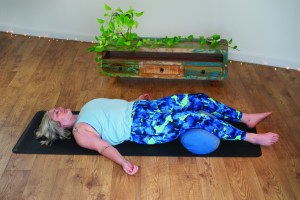
Time: As long as needed to drift off
Why it helps: Give an overactive mind something else to focus on with a body scan. Finding all the areas where you are holding onto tension, and encouraging them to relax, helps you fall asleep again.
Getting there: If you like to rest on your back, try popping a pillow underneath your knees to help make the lower back more comfortable. If you prefer to lay on your side, put a pillow between your knees to support the top leg. Focus on your next five breaths – make them deep and even, sighing the exhale out through the mouth.
Being there: When you’re ready, begin to mentally scan your body and encourage it to relax. Start at the crown of the head, work down through the muscles of the face and jaw, drop the tongue from the roof of your mouth and then move systematically down through the body – shoulders, arms, hands, chest, belly, hips, legs… right the way down to the tips of the toes. When you have finished, bring your attention back up through those same points to the crown of the head, and repeat as many times as you need until you fall asleep.
Extending the out-breath
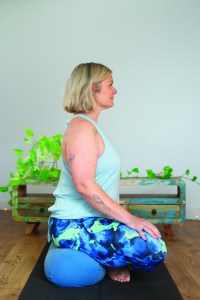
Time: At least 15 rounds
Why it helps: Extending the exhalation triggers your parasympathetic nervous system, stimulates the vagus nerve and helps to reduce cortisol and adrenaline in the body, calming the body and mind.
Getting there: You can be fully reclined or sit upright, it’s up to you. If sitting, try leaning against a wall so it takes less effort to remain upright.
Being there: Once you’re settled, take three deep breaths, in and out through the mouth, before allowing your breath to settle back into a natural rhythm. Begin to count the length of your inhalation and then count the length of the exhalation. Gradually begin to focus on lengthening the out-breath on each round, aiming to stretch it out to double the length of the in-breath (if you inhale for 4, exhale for 8). You might find it helpful to build in a little pause before and after each breath if it feels comfortable. Repeat these longer exhalations as long as feels natural, ideally for at least 15 rounds.
If you’ve slept poorly, these gentle stretches will help set you up for a positive day ahead
Reclined goddess over a pillow
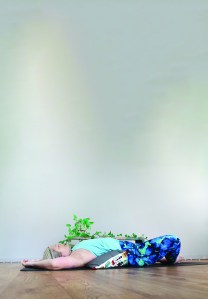
Time: At least 10 breaths
Why it helps: This pose in the yoga for better sleep sequence calms the system and gently stretches your body, while the deeper breath helps to wake you up.
Getting there: Lie over a pillow that supports the back of the ribcage and creates a gentle stretch through the front chest. You can keep the legs outstretched, or bring the soles of the feet together and let the knees drop open to either side (pictured), whichever feels best. If your legs are to the sides, try placing a yoga block or cushion beneath each knee to avoid overstretching the groin. Bring the arms to rest out at shoulder height or above the head (pictured).
Being there: Rest for a minimum of 10 breaths, focusing on deep, nourishing inhalations. Gradually become aware of your surroundings and notice how your body feels. Taking time to nourish after a poor night’s rest is the perfect way to start the day.
Cat/cow
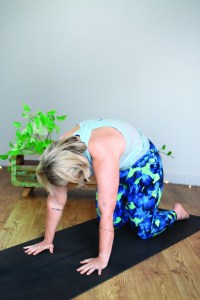
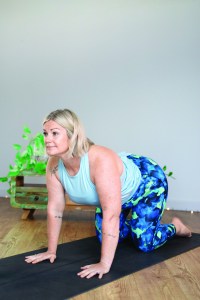
Time: Until you feel your spine is fully mobilised
Why it helps: Gently flexing and extending your spine wakes up the body and provides you with some much-needed movement in the morning.
Getting there: Kneel on all-fours and gently lengthen from your crown to your tailbone. Notice how your back feels.
Being there: As you inhale, drop the belly to the floor, roll the shoulders back and gently lift the gaze, lengthening the front body (1). As you exhale, push the floor away with your hands, tuck your tailbone under and round into the upper back, flexing the spine and stretching through the back of the shoulders (2). Gently switch between these two positions in rhythm with your breath.
Morning flow
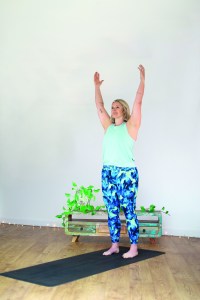

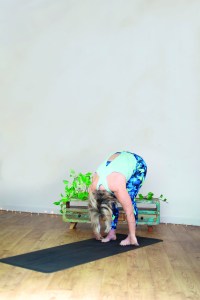
Time: At least 3-5 rounds
Why it helps: This flow helps to build your energy before you start the day, after a night spent trying out the yoga for better sleep moves.
Getting there: Come to standing, feet shoulder-width apart, and take a couple of breaths to check in.
Being there: When you’re ready, use an inhalation to stretch the arms overhead (1) – lengthen up as much as you can before exhaling into chair pose (2). This doesn’t need to be deep or challenging, it’s just about encouraging the larger muscle groups to work and to pump the blood around your body.
Pause for an inhale and then on your next exhalation, gently cascade the upper body down into a forward fold (3), where you can dangle and relax the spine as much as is comfortable – don’t forget to bend your knees to keep the hamstrings comfortable. When you’re ready, use an inhalation to sweep back up to standing and begin the flow again.
When you’ve finished, pause in the standing position and take a few breaths, then set an intention for your day ahead. Think about finding a positive statement you can keep referring back to through your day, to help you focus forward rather than dwell on the restless night you’ve just had.

